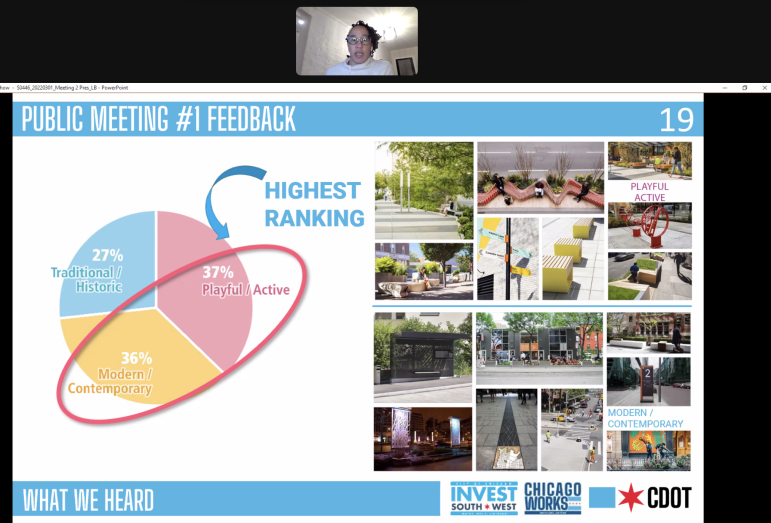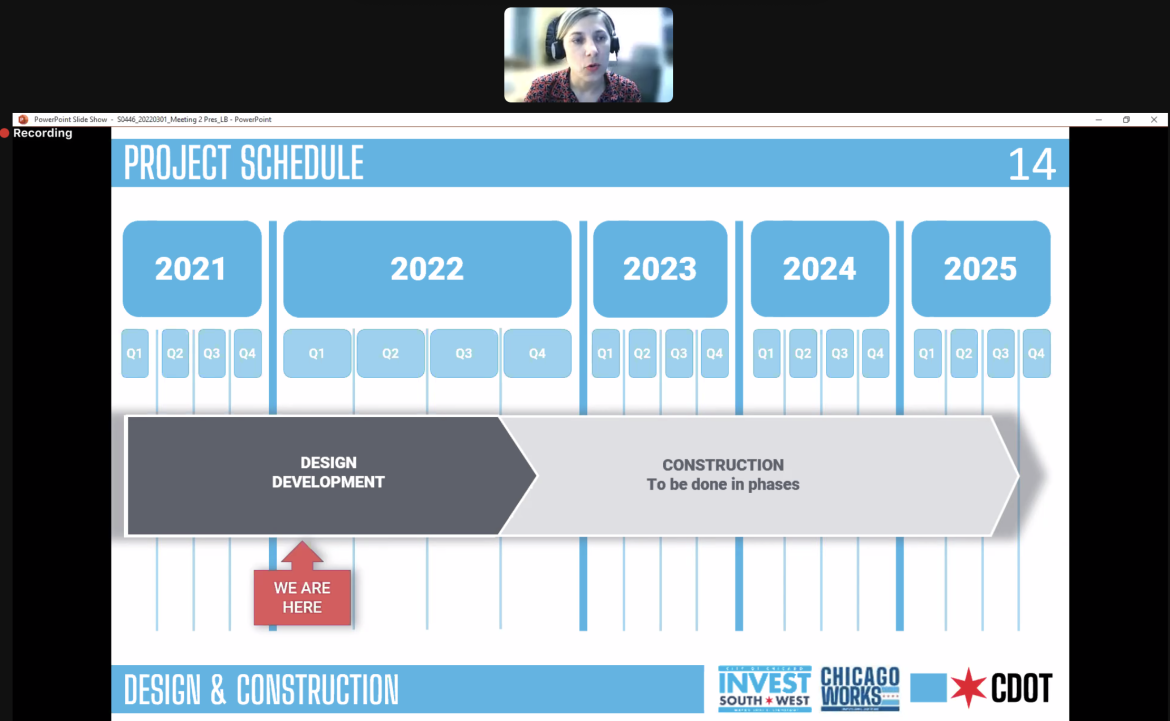Three design themes for the Soul City Corridor improvement project are being considered by the Chicago Department of Transportation.
The themes – “rooted in place,” Chicago rhythm” and “successful future” – draw on Austin’s cultural history and were announced last week as officials updated residents on the INVEST South/West-funded project.
The project, which covers 1.5 miles of Chicago Avenue from Austin Boulevard to Cicero Avenue, is in the design development phase, which includes deciding what features will be part of the thoroughfare and how they will look.
The design team, led by Lamar Johnson Collaborative, identified the three themes after getting input from community members.
“Rooted in place” uplifts the value of family for community members, and celebrates historic entrepreneurs on the corridor and the legacy of the Great Migration.
“Chicago rhythm” highlights Austin’s valuable contributions to arts and culture, recognizes the musical heritage and new styles developed in the community, and celebrates dance.
“Successful future” inspires and focuses on improving quality of life for future generations.
The theme ultimately chosen will inform the “look and feel” of the Soul City Corridor, said Lubka Benak, project director of CDOT’s Livable Streets program, which oversees the Chicago corridor improvement project.
Benak said corridor improvements will include making the street more accessible; building new sidewalk curbs and gutters; installing curb extensions and ADA ramps; erecting new street lights and light pole identifiers; planting trees and other potential landscaping.
During last week’s virtual meeting, results from the first public workshop held in August 2021, where community members voted on the overall “look and feel” of the Chicago Avenue corridor, were shared.

The tally from last summer’s meeting was: 37% of community members voted for “playful/active,” 36% voted for “modern/contemporary,” and 27% voted for “traditional/historic.”
“As we look at these survey results, as the consultant team, we think of these as one of the key themes,” said Lesley Roth, with Lamar Johnson Collaborative.
Roth also shared how residents prioritized various user groups and their needs.
The design’s team goal is to have an approach that can balance different needs as they design the corridor, such as increasing sidewalk space; maintaining parking; improving pedestrian, bus, and bike circulation; and accommodating cars.
“We also really pay attention to what the highest-ranking needs are. As you can see from the study, that would be the pedestrian experience,” Roth said. “That was one of the reasons why we increased the sidewalk space, where possible, in the new roadway design.”
The project team said the design process will continue to engage community members through public meetings and a series of small groups workshops in the next few weeks until residents feel comfortable with a design.
Then, the final design concept will be presented in a public meeting, where residents will again rank their preferences. It’s possible the design will be tweaked after that, with construction expected to begin in the fall.
“I can tell you everyone’s input is important if we wanna have some skin in the game to make sure that we’re making Chicago Avenue reflective of our community,” Ald. Emma Mitts (37th) said.
The project team also shared examples of other corridor improvement projects in the city with community identifiers that represent the heart and soul of a neighborhood. These examples included the Fulton Market in the West Loop, the 95th Street corridor from Damen to Western avenues, and the Roosevelt corridor near Michigan Avenue.
Those projects used key themes that arose out of community conversations to design and build custom streetscape elements like gateways, light poles and street furnishings with specific colors, styles and fonts.
Youth participation has been a key component in gathering feedback to create place-making elements that will be implemented along with the streetscape, Roth said.
In a series of workshops organized last fall with the help of Territory, a youth urban design and architecture nonprofit in Austin, 17 youth people identified the key priorities, challenges and opportunities for teenagers in Austin.
Roth said the youth component is very important when taking a universal design approach that responds to the needs of all group ages.
“Youth engagement was extremely important during the course of this project because many times, planning processes only engage adults,” Roth said. “And there are a lot of youth, in and around Austin who use Chicago Avenue.”
Youth identified peace circles as a key component to include in the streetscapes. They can be incorporated as outdoor seating elements that promote community conversations and restore a sense of peace and safety along the corridor.
Participating youth identified a second design element, called stand, that would create patterns in the pavement along the sidewalk to differentiate areas of activity along Chicago Avenue, such as outdoor seating and pedestrian walkways.
The young people thought it would be important to help visitors navigate the corridor and orient them to the different activities, businesses and amenities in the community.
A third component proposed by youth, called strut, focuses on fostering a sense of belonging and ownership along the corridor with the use of street lights and other streetscapes elements.
The youth proposed “a runway” to highlight “the great stuff that is happening and all of the great people” in Austin, Roth said.
Mike Folkening, from Civiltech, said the street design process combines community feedback with data and technical analysis, such as traffic volumes and crash statistics. This helps identify opportunities for safety and mobility improvements while balancing travel priorities for all roadway users.
In 2018, the city of Chicago reported Austin is one of 12 neighborhoods with significantly higher rates of crashes that cause death and injury compared to Chicago’s average.
“We have taken a balanced approach, one that looks at the needs of everyone – those that are driving, are riding bikes, walking, truck deliveries – every possible mode,” Folkening said. “It is important to recognize that pedestrians are the most vulnerable user group, so our design really focuses on the pedestrians and the pedestrian experience.”
Redesigning the street could include widening sidewalks wherever possible and adding elements, like intersection bump-outs, which reduce the turning speed of vehicles and the distance that pedestrians must cross, Folkening said.
He added the team is also prioritizing the need to maintain as much street parking as possible, a need expressed by business owners during small groups sessions.
“We’re doing everything we can to maintain as much street parking as possible and providing better street parking accommodations to create a vibrant street that supports economic development,” Folkening said.
Lubka invited Austin residents to participate in the upcoming small group sessions and public meetings to be held in the spring that will help finalize the design process.
Construction of the first section of the corridor, from Austin Boulevard to Laramie Street, is expected to begin in the fall. Construction for the remaining two sections of the corridor will continue until 2025, with the work expected to finish in early fall of that year.
“As you can see, there’s definitely a lot of community pride and a desire to have real cultural representation and iconic markers that are representative of the community in a variety of different ways,” Roth said.
A recording of the meeting and more information about the Soul City Corridor can be found here.
To learn more about Territory, including opportunities for youth to participate, contact Helen Slade at helenslade@territorychicago.org
